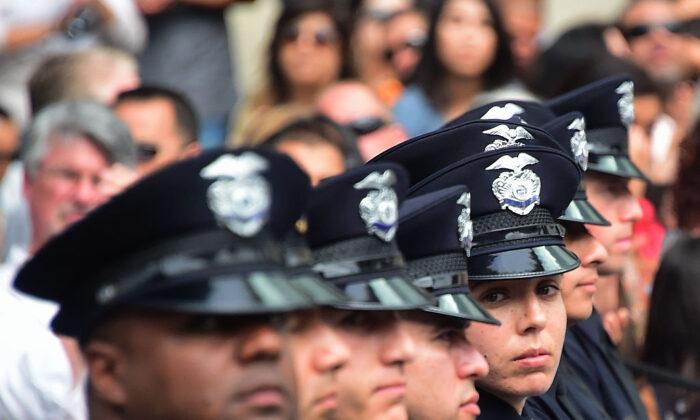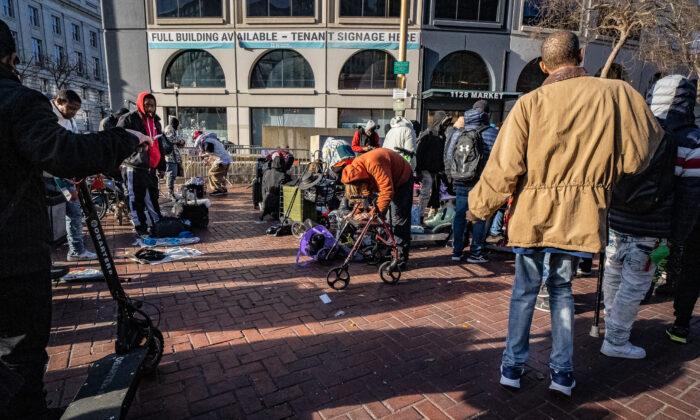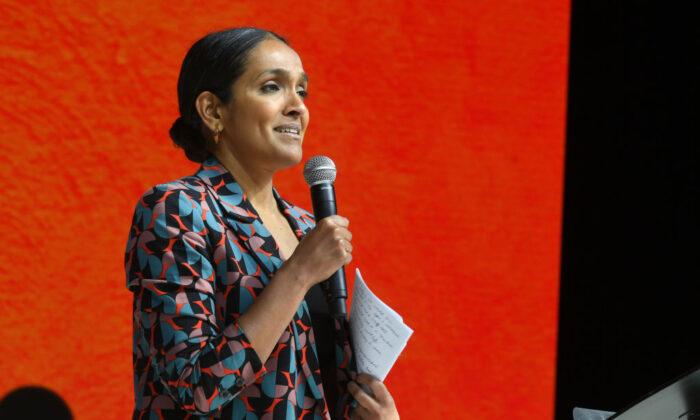LOS ANGELES—In a fenced compound in the heart of the San Fernando Valley sits a young woman wearing a black mask covered with gold-glitter butterflies.
The compound, on Chandler Boulevard in the North Hollywood neighborhood of Los Angeles, opened last month on what used to be an overgrown, empty lot. Now, the lot is lined with 39 red, white, and blue sheds—and the young woman calls one of them home.
Maria, 25, moved into the Chandler Boulevard Bridge Home Village in North Hollywood on Feb. 2. It’s the latest supportive housing development to help Los Angeles County’s growing homeless population.
For homeless people such as Maria, the tiny home village’s facilities and services offer them 90 days to turn their lives around. She said thinking of her son gives her the strength and motivation to carry her over the 90-day transitional threshold.
“I have a difficult time trying to even open up about my life,” Maria told The Epoch Times, as her eyes became glossy.
Her father died before she was born, and she grew up on a block where she was always surrounded by drug deals and violence, she said.
She’s been homeless for about five years now, in and out of gang activity in the valley. She got pregnant in the midst of it all. Her son, who will be 2 this year, was taken away from her, though she didn’t say why.
“So, me having to go through so much—being homeless twice, having to lose my son—has me more motivated than ever to actually complete my goals,” she said.
Some of those goals include enrolling in an online school, earning her GED diploma, getting her Social Security card, going to counseling, and getting her son back. Maria said her room at the new tiny home village, and the services provided there, will make that possible.


Inside a Tiny Home
Each of the community’s 64-square-foot homes—also known as “pallets”—contains two beds, lights, power outlet, laundry basket, smoke detector, emergency exit, heat, and air conditioning. For personal items that don’t fit inside the unit, residents are provided with extra storage: their own 60-gallon bins, locked away behind a chained fence on the premises.In the Chandler Boulevard village, 35 of the 39 units are currently occupied. Each pallet houses one person due to COVID-19 regulations, except in cases of couples. The village admits people aged 18 and above.
Security guards monitor the grounds 24/7, and there are also cameras on site. When residents return to their homes, they go through a security checkpoint. No weapons or drugs are allowed inside the community.
“The tiny homes are great,” said one resident, flashing a thumbs-up to visiting The Epoch Times staff.
Maria said the community has helped her by providing “basic stuff” that most people take for granted, like showers, meals, and a washer and dryer to clean her clothes.
Case managers are on-site five days a week. They check in with the residents, and help them get their state documents organized so they can transition into permanent housing in three months—though it may take longer for those with serious drug addiction and mental health issues.
Maria is confident she’ll be ready to transition out of the program at the end of the 90-day period.
“I have overcome a lot,” she said.
Reflecting on her past, Maria said “dysfunctional families” and “the areas they were raised in” contribute to a person becoming homeless.
“A lot of that violent activity that comes with drugs, it comes with domestic violence. It comes in [mental] abuse, verbal abuse, mental illness. And at the end of the day, I do fall under all those categories,” she said.
But she realized that if she continued to be a gang member, “causing all this commotion and crisis in the neighborhood that I live in,” in the end, she wouldn’t be happy.
“Because I’m not happy, I lost my son,” she said.
So she turned to Hope of the Valley, the faith-based nonprofit organization dedicated to helping the homeless, to turn her life around.
She compared what she’s going through to a metamorphosis.
The Tiny Homes Movement
Chandler Boulevard’s tiny home village—the first in the city of Los Angeles—is run by staff and volunteers of Hope of the Valley, which operates nine shelters throughout the San Fernando Valley. Redondo Beach previously debuted its own similar Tiny Homes village last year, and three more San Fernando Valley locations are scheduled to open in 2021.According to Rowan Vansleve, Hope of the Valley’s chief finance and administration officer, each unit cost $6,000 to build—but because the land “was a dumping ground” before construction began, the costs spiked.
“For us to use it as a safe facility, I know they spent over $2 million preparing the land and getting it ready, but it is still the cheapest bed cost in the city at $55,000 per bed,” Vansleve said. “It was an unused piece of land that was overgrown. It had an encampment on it. It had no power, no sewage—both of which they had to install.”
The developers erected two telegraph poles to bring power to the site and ran a 600-foot sewage line for waste disposal, Vansleve said—both costly.
“I know a lot of people want to throw stones at the price tag, because you see these very big numbers,” Vansleve said, but housing people in L.A. is “incredibly expensive.”
He says it’s worth it.
“When you house people, they stay housed. People change. What we’ve got to do is, we’ve got to address the whole problem,” he said. “We are going to have to accept that building housing in Los Angeles is not going to be fast, and it’s not going to be cheap. The city of Los Angeles is a massive city. And like any big city, there’s a bureaucracy.”


‘The Catch Zone’
Finding homeless people interested in housing is another hurdle for outreach workers to overcome.Christopher Hernandez is one of the case managers on site. He told The Epoch Times that outreach workers cover a 3.5-mile radius around the tiny home community called “the Catch Zone,” where they reach out people in need and explain their options for temporary housing.
If they’re interested, the outreach workers will offer information. But the transition into living in any kind of shelter isn’t easy for them, said Hernandez, adding that many have gotten used to the lifestyle on the streets and suffer from crippling PTSD.
“The transition is a little hard too, just because a lot of these people, they’ve been homeless for quite a while, and they’ve kind of learned how to survive on their own, doing what they need to do to survive, not having anybody tell them what to do, how to follow certain rules or being back at a certain time,” he said.
Residents have a curfew from 10 p.m. to 6 a.m., and if they’re gone for more than three days, they’re not allowed to return to the village.
“We can’t force anybody to come here, because they’re adults,” said Hernandez. “If they need drug treatment, you know, we can refer them, but we can’t make them do anything they don’t want.”
New Paperwork
One of the biggest challenges many homeless people face is not having a birth certificate, Social Security card, or any federal documentation typically needed for employment or getting into low-income housing. The nonprofit is doing all it can to help the residents, including providing counseling services, rehab referrals, and employment resources.Hernandez said one of the most rewarding experiences is seeing the smiles on people’s faces when they receive their documents. Many have had theirs stolen while on the streets, or have just lost them over the years.
“It’s just amazing … and that’s just the document, that’s just a form of identification. And that makes them really happy,” he said.
Jamie Carmona, an on-site Hope of the Valley outreach worker, told The Epoch Times that based on her experience, many homeless people come to California from another state. In the tiny homes village, seven participants are originally from other states, she said, but have been in California since the pandemic began.
Carmona, who has worked in homeless services for six years, said she’s heard from participants in her programs that people come to California for the weather—and because the state “specifically gets all this money for the homeless.”
She said temporary housing is a good way for outreach workers to keep track of people, so they’re ready when it’s their time to be placed into supportive housing. Workers often seek out clients who have housing vouchers when housing becomes available, only to find they’ve disappeared.
The clients go back to their encampments after receiving the vouchers, but when the worker seeks them out there to follow up, “Where did they go? They moved their encampments because of the sweep,” she said.
Solution for a Growing Problem?
In October, Los Angeles Controller Ron Galperin released an Action Plan to Advance Proposition HHH, a measure passed by voters in 2016 to issue $1.2 billion in general obligation bonds with the aim of creating housing for the homeless.Galperin’s report found the rate of homelessness was increasing faster than housing was being built. Only three projects under Proposition HHH funding had been completed, containing 179 supportive housing units and 49 non-supportive units, five years after the measure passed.
Meanwhile, over 41,000 people were homeless in L.A. in the latest Greater Los Angeles homeless count—a 16 percent increase from 2019 to 2020, and a 45 percent jump from 2016. Nearly 70 percent of them were unsheltered.
According to recommendations made by Galperin, the county should apply a portion of Proposition HHH funds to develop easier-to-construct temporary housing units, like the tiny home villages, to provide shelter while larger supportive housing projects remain in the pipeline.
Hope of the Valley’s Vansleve said the problem needs to be addressed, no matter who does it.
“When you walk through North Hollywood, you are left heartbroken by the number of people that you will see in encampments within a stone’s throw of the tiny home community,” Vansleve said.
“And I truly believe that if we don’t address this, you’re gonna hurt your business community. People aren’t going to want to walk the streets and frequent your restaurants and go to your shops if they don’t feel safe, and overwhelmingly what North Hollywood has become, in certain parts, is what so much of Los Angeles is.”
Vansleve said the solution “doesn’t just work if it’s just the government or the nonprofits,” or either of those in isolation. He said there needs to be a public-private partnership between the city and its citizens.
The Chandler Boulevard tiny home village was built, funded, and developed by the city of Los Angeles. City Councilman Paul Krekorian, who spearheaded the construction, didn’t respond to requests by The Epoch Times for comment by press time.
The effects of the COVID-19 pandemic are also worrisome for those working in homeless services. Thousands of layoffs in California, combined with an economy that’s not fully reopened, may result in a new wave of unsheltered people, officials fear.
“We know that homelessness is gonna explode; with seeing the numbers we’ve seen anecdotally, it’s coming,” Vansleve said.
“I would conjecture that a lot of the people who are becoming homeless are still couch surfing, or they’re still, you know, renting a garage where they’re packed in, and they’re doing what they can. My fear is, probably three or four, maybe six, months from now, we’re going to see a wave. It’s going to overwhelm the system.”
The next village, with more than 100 units, is slated to open in the San Fernando Valley next month.





